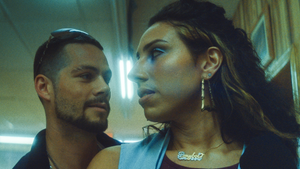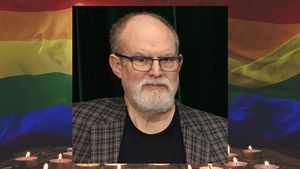We have officially kicked off Transgender Awareness Week — which is about to turn into just “Transgender Awareness” come 2025 when the United States turns into Gilead from The Handmaiden’s Tale — but I digress.
We are not here to dwell, but what we are here to do is bring awareness to the community and focus on trans joy along the way. Including exploring the history and meaning of the Transgender Pride Flag. While you may have seen this flag, characterized by its baby blue and pink colors with a white strip in the middle, you may not know much about what it fully stands for or how it came to be. So, here are 10 fascinating facts you can add to your queer trivia knowledge!
1. It was designed by activist Monica Helms in 1999

lev raddin/Shutterstock
The flag’s initial design came from transgender activist Monica Helms, a US Naval officer, back in 1999. Helms had served in the Navy since the 1970s and continued to be a voice and an advocate for the community following the creation of the flag. She even took on President Trump during his initial presidency in 2017 when he said transgender people couldn’t serve in the miltary, noting that many of our allies around the world had openly trans people in their militaries with no issues. Michael Page, the activist behind the bisexual flag, also initially encouraged Helms to create the flag.
2. It debuted in 2000 at the Phoenix Pride Parade

cunaplus/Shutterstock
Following the flag’s creation, Helms, a Phoenix native known as the “transgender Betsy Ross,” debuted the flag during the 2000 Pride Parade in Phoenix, Arizona. Helms also returned twenty years later to claim the title of the Phoenix Pride grand marshal to honor and recognize her contributions to the community’s history.
3. The colors have significant meaning

Savvapanf/Shutterstock
In 2020, Helms told Atlanta Magazinethat she’d woken up one day with the idea for the colors and broke down what they mean in more detail. “The traditional color, light blue, for boys, pink for girls, and a single white strip in the middle for those who are transitioning, gender neutral, or intersex,” she said. Following the creation, she said she took it to “protests, marches, funerals, and transgender days of remembrance,” but that it didn’t start gaining real traction until 2013.
4. It was one of the first additional Pride Flags flown in government buildings

Flystock/Shutterstock
Although it took a while for the flag to gain the recognition it has since gone on to achieve, it also made its way into some government buildings in the UK before its global accolades. In 2010, the councils in Brighton and Hove flew the Transgender Pride Flag on November 28 in honor of Transgender Day of Remembrance. Although the flag flew in plenty of other places, this marked a significant turn in governmental awareness.
5. The pattern is a distinctive shape

VectorPlotnikoff/Shutterstock
In line with the colors having significant meaning within themselves to represent the genders, those transitioning, or those either neutral or intersexed, Helms also said the pattern has its own meaning, too. “The pattern is such that no matter which way you fly it, it will always be correct,” she said. “This symbolizes us trying to find correctness in our own lives.”
6. You can see the very first flag at the Smithsonian

Felix Mizioznikov/Shutterstock
During Helms’ decade of trying to spread awareness of the flag, it took other countries flying the flag before people started to take note. On August 19, 2014, The Smithsonian National Museum of American History in Washington, DC, accepted her donation of the original flag as a part of their LGBTQ+ collection. It is still there, and can also be found outside of offices of the likes of Bernie Sanders and Nancy Pelosi.
7. It’s gone on to inspire other Pride Flags

Danler/Shutterstock
The popularity of the Transgender Pride Flag also paved way to inspiring other LGBTQ+ flags, perhaps most notably the Progress Pride Flag created by Danial Quasar in 2018. This flag incorporates the traditional rainbow Pride Flag alongside elements from the trans flag tht bring awarness to more marginalized groups within the LGBTQ+ community. In 2023, Quasar told The Trejor Project that he’d “had an epiphany that all of these flags matter to each person and they’re flying them for their own reasons. It just shows the grand diversity and sheer individualism that we have within our community that is so beautiful."
8. Alternative versions of the Transgender Pride Flag exist

Michelle Lindsay's "Trans Flag" design
Other, lesser-known variations of the Transgender Pride Flag exist, including one by Ottawa designer Michelle Lindsay around 2009. This one also consists of pink and blue stripes, though darker shades, and the symbol for both male and female are combined via the white stripe in the middle. It was first displayed during the Ottawa community’s Trans Day of Remembrance ceremony, as it’s also known as the Transgender Remembrance Flag.
Other flags include the Israeli Transgender Flag, represented with a bright green background and the same male/female combination symbol in the center, though in black instead of white. Little is known about the origin of this flag. There is also the Jonathan Andrew “Captain John” variation that, in 2015, he said he could not ever fund to properly produce.
9. There’s also a Genderqueer Flag

Marilyn Roxie Genderqueer Flag
Although the white stripe in the popularized version of the Transgender Pride Flag represents our nonbinary friends, Marilyn Roxie designed a flag for the genderqueer and non-binary community. The first design first debuted in June 2010, and after three redesigns, made its final reveal one year later. This flag also has horizontal bars that have a deeper meaning, including lavender, which is a mix of blue and pink to represent androgyny, white for the agender community, and dark chartreuse green for those outside of the binary, a color considered the inverse of lavender.
10. You can read more about Monica Helms’ experience in her autobiography
In 2019, Helms released her autobiography, More Than Just A Flag, that details everything in her life from her time as a Navy veteran through to the book’s publication. It goes into further detail about her creation of the Transgender Pride Flag in 99, as well as her donation to the Smithsonial and her founding of the Transgender American Veterans Association in 2003.








































































































































